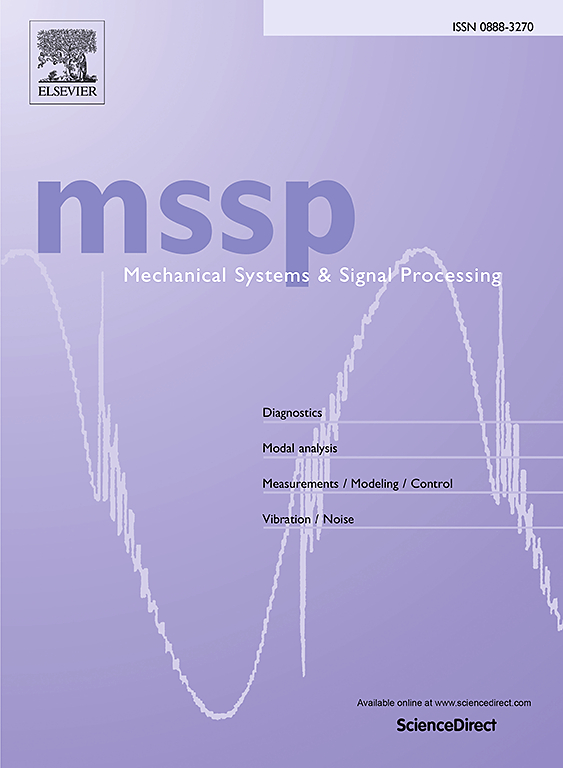基于多尺度自适应注意力变压器的超声Lamb波损伤识别
IF 7.9
1区 工程技术
Q1 ENGINEERING, MECHANICAL
引用次数: 0
摘要
本文提出了一种新的无监督迁移学习方法——多尺度自适应注意转换域自适应网络(MAAT-DAN),用于结构损伤的回归和分类识别。MAAT-DAN由三个主要组件组成:特征提取器、域适配器和标签预测器。该特征提取器首次引入了一种新颖的动态自适应加权模块,该模块通过根据输入调整注意头权重来增强多头注意。此外,采用多尺度特征提取技术,从结构健康监测常用的兰姆波中同时提取三个不同尺度的损伤特征。标签预测器由多个完全连接的层组成。MAAT-DAN的领域适配器集成了用于管理高维数据的梯度反转层、用于提高稳定性的最大平均差异和用于支持有效领域适应的特征重建技术。通过两个特别设计的超声实验,验证了MAAT-DAN在回归和分类任务中的性能:(1)在回归实验中,使用两种不同材料的试验梁和Blu-Tack模拟增强铝板的可重复损伤;(2)分类,在钢制水箱上进行实验,部署两对传感器,历时两年收集数据。它的特征提取器和域适配器通过自定义度量与使用这些数据集的其他五种方法进行比较。结果表明,MAAT-DAN在两种任务中均获得了最高的预测精度和一致的预测稳定性,证明了其在无监督域自适应损伤识别中的有效性。本文章由计算机程序翻译,如有差异,请以英文原文为准。
Damage identification using ultrasonic Lamb waves with multi-scale adaptive attention Transformer-based unsupervised domain adaptation
In this paper, a novel unsupervised transfer learning method – the Multi-scale Adaptive Attention Transformer Domain Adaptation Network (MAAT-DAN) is proposed for structural damage identification in regression and classification tasks. MAAT-DAN comprises three main components: a feature extractor, a domain adapter, and a label predictor. The feature extractor, for the first time, introduces a novel dynamic adaptive weighting module that enhances multi-head attention by adjusting attention head weights based on the input. Additionally, a multi-scale feature extraction technique is employed to simultaneously extract damage features at three different scales from Lamb waves, a popular means in structural health monitoring. The label predictor is composed of multiple fully connected layers. MAAT-DAN’s domain adapter integrates a gradient reversal layer for managing high-dimensional data, maximum mean discrepancy for improved stability, and feature reconstruction techniques to support effective domain adaptation. MAAT-DAN’s performance is validated in both regression and classification tasks using two specially designed ultrasonic experiments: (1) for regression, an experiment on a reinforced aluminum plate using test beams of two different materials and Blu-Tack to simulate repeatable damage; (2) for classification, an experiment on a steel water tank deploying two pairs of sensors to collect data over two years. Its feature extractors and domain adapters are compared across customized metrics against five other methods using these datasets. Results show that MAAT-DAN achieved the highest prediction accuracy and consistent prediction stability in both tasks, demonstrating its effectiveness in unsupervised domain adaptation for damage identification.
求助全文
通过发布文献求助,成功后即可免费获取论文全文。
去求助
来源期刊

Mechanical Systems and Signal Processing
工程技术-工程:机械
CiteScore
14.80
自引率
13.10%
发文量
1183
审稿时长
5.4 months
期刊介绍:
Journal Name: Mechanical Systems and Signal Processing (MSSP)
Interdisciplinary Focus:
Mechanical, Aerospace, and Civil Engineering
Purpose:Reporting scientific advancements of the highest quality
Arising from new techniques in sensing, instrumentation, signal processing, modelling, and control of dynamic systems
 求助内容:
求助内容: 应助结果提醒方式:
应助结果提醒方式:


